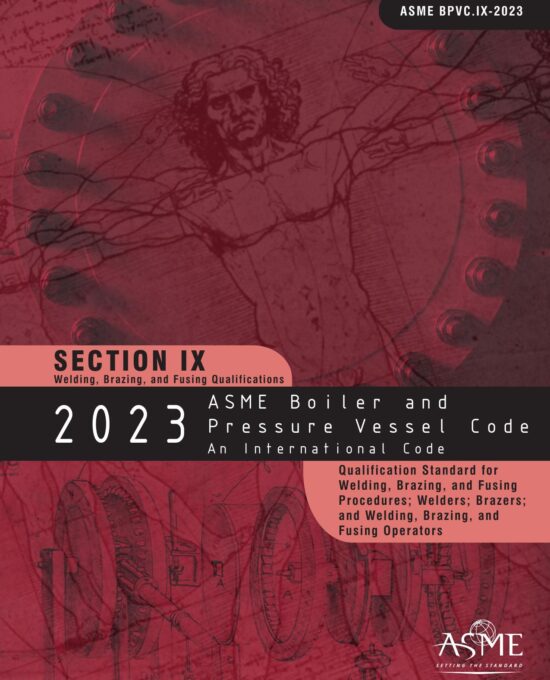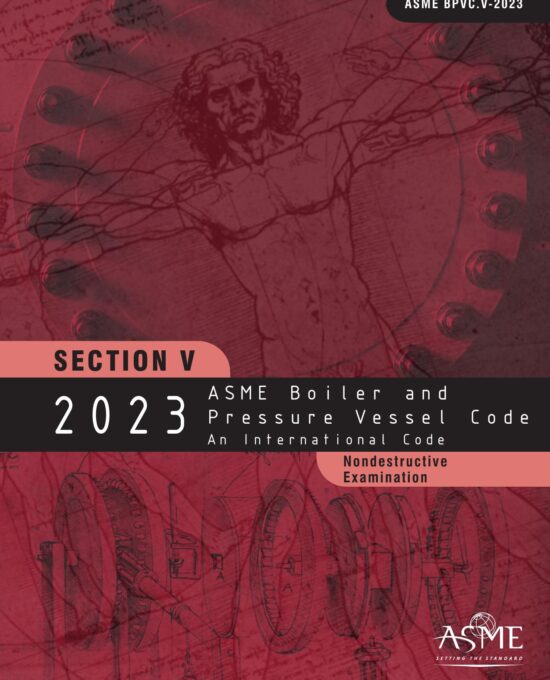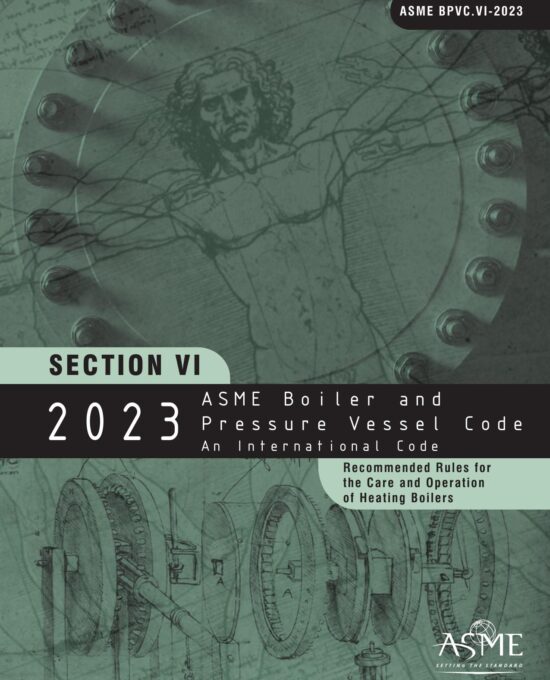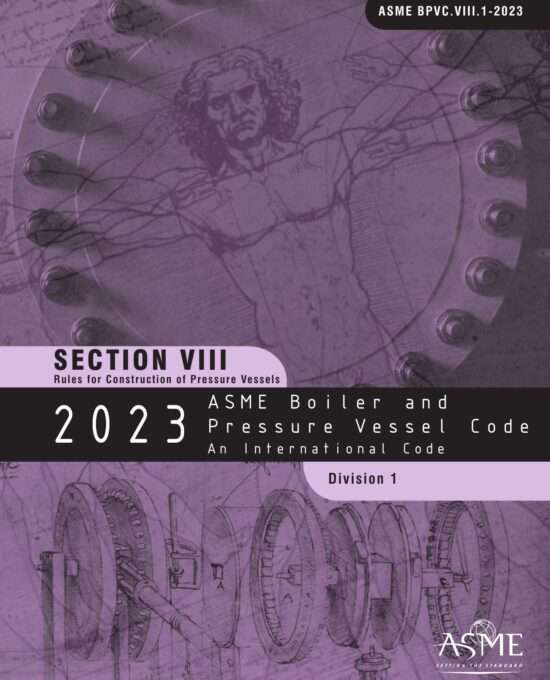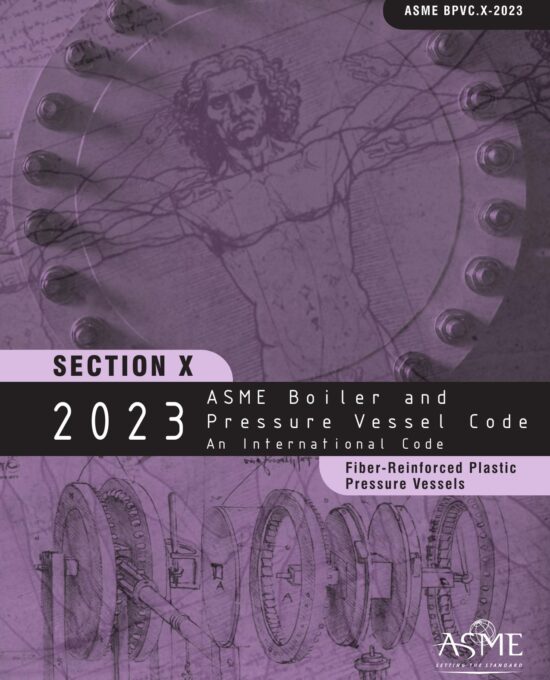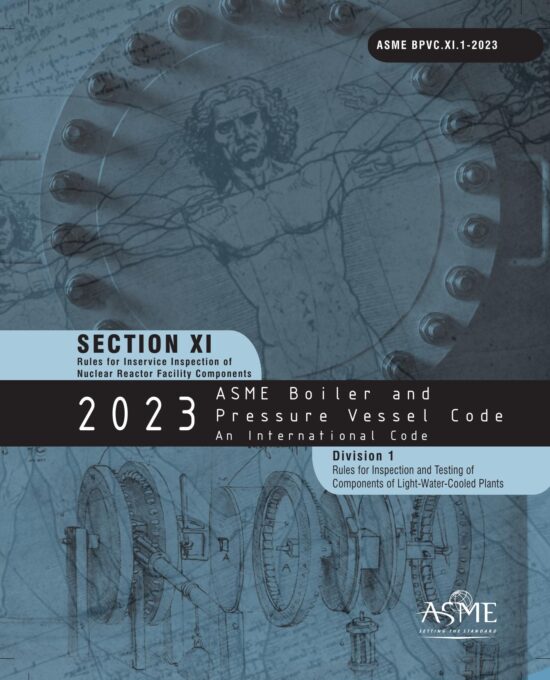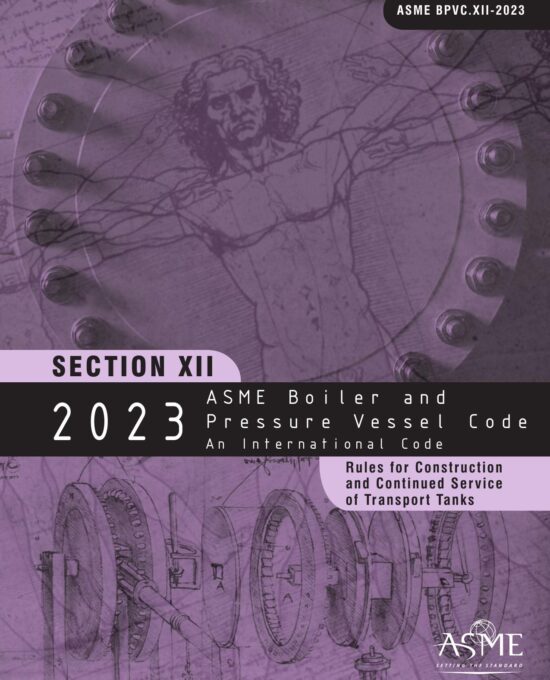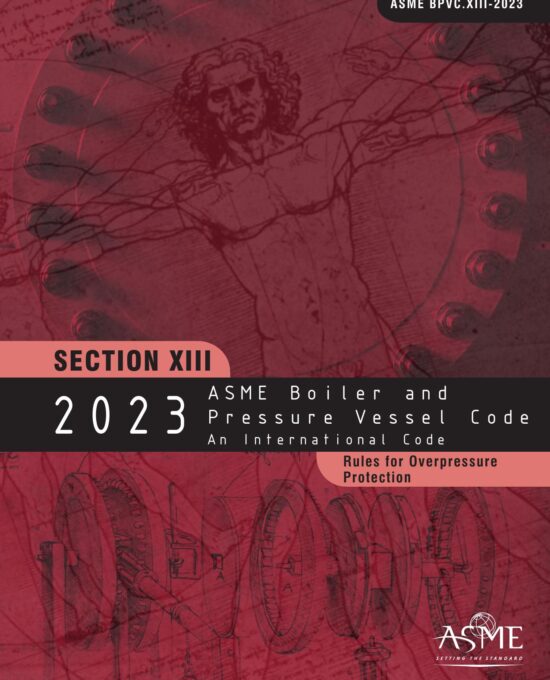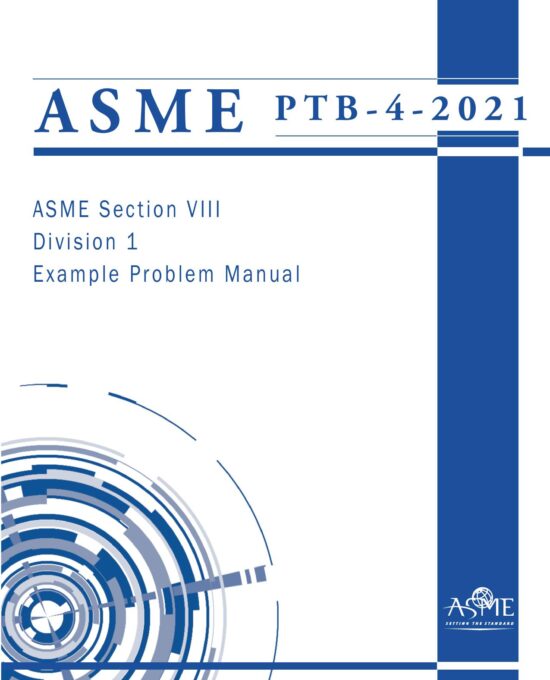ASME BPVC Section IX: Welding, Brazing, and Fusing Qualifications, 2023
ASME BPVC Section IX – 2023 outlines the requirements for the qualification of welding, brazing, and plastic fusing procedures, as well as the performance of welders, brazers, and fusing operators. This standard is critical for ensuring the structural integrity and code compliance of pressure-retaining equipment constructed in accordance with the Boiler and Pressure Vessel Code.
Highlights:
- Qualification variables, acceptance criteria, and testing methods
- Standard formats for Welding Procedure Specifications (WPS), Procedure Qualification Records (PQR), and Performance Qualifications (WPQ, BPQ, FPQ)
- Guidance for tube-to-tubesheet welding and waveform-controlled welding
- Support for additive manufacturing (wire-additive welding)
- Annexes on ISO harmonization and international qualification recognition
Who It’s For:
Manufacturers, inspectors, welding engineers, and QA professionals qualifying welding, brazing, or fusing operations in accordance with ASME Code requirements for pressure-retaining components.
BPVC.IX-2023
ASME BPVC Section IX: Welding, Brazing, and Fusing Qualifications, 2023
ASME BPVC Section IX – 2023 outlines the requirements for the qualification of welding, brazing, and plastic fusing procedures, as well as the performance of welders, brazers, and fusing operators. This standard is critical for ensuring the structural integrity and code compliance of pressure-retaining equipment constructed in accordance with the Boiler and Pressure Vessel Code.
Highlights:
- Qualification variables, acceptance criteria, and testing methods
- Standard formats for Welding Procedure Specifications (WPS), Procedure Qualification Records (PQR), and Performance Qualifications (WPQ, BPQ, FPQ)
- Guidance for tube-to-tubesheet welding and waveform-controlled welding
- Support for additive manufacturing (wire-additive welding)
- Annexes on ISO harmonization and international qualification recognition
Who It’s For:
Manufacturers, inspectors, welding engineers, and QA professionals qualifying welding, brazing, or fusing operations in accordance with ASME Code requirements for pressure-retaining components.
BPVC.IX-2023
ASME BPVC Section V: Nondestructive Examination, 2023
ASME BPVC Section V – 2023 defines the requirements for nondestructive examination (NDE) of materials, welds, and components in pressure-retaining systems. It ensures safety, reliability, and code compliance by detailing standardized inspection methods used during fabrication, installation, and in-service evaluations. This section is applicable across industries that manufacture or maintain boilers, pressure vessels, and related equipment.
Highlights:
- Covers radiographic, ultrasonic, magnetic particle, liquid penetrant, and visual examination
- Provides mandatory and nonmandatory appendices for technique-specific guidance
- Details examination procedures, calibration, documentation, and system accuracy
- Defines personnel qualification requirements aligned with ASNT SNT-TC-1A and CP-189
- Includes digital radiography, phased array UT, and time-of-flight diffraction (TOFD)
- Introduces updates for imaging systems, flaw sizing, and automation compatibility
- Defines essential variables for procedure qualification and process validation
- Supports both fabrication and in-service inspection activities across industries
- Fully integrates with Section II (Materials), Section IX (Welding), and Section XI (Inspection)
Who It’s For:
NDE technicians, engineers, code officials, and QA professionals responsible for verifying the quality and integrity of welded, cast, or formed pressure equipment. Enables compliant execution of ASME-regulated inspection and reporting protocols.
BPVC.V-2023
ASME BPVC Section V: Nondestructive Examination, 2023
ASME BPVC Section V – 2023 defines the requirements for nondestructive examination (NDE) of materials, welds, and components in pressure-retaining systems. It ensures safety, reliability, and code compliance by detailing standardized inspection methods used during fabrication, installation, and in-service evaluations. This section is applicable across industries that manufacture or maintain boilers, pressure vessels, and related equipment.
Highlights:
- Covers radiographic, ultrasonic, magnetic particle, liquid penetrant, and visual examination
- Provides mandatory and nonmandatory appendices for technique-specific guidance
- Details examination procedures, calibration, documentation, and system accuracy
- Defines personnel qualification requirements aligned with ASNT SNT-TC-1A and CP-189
- Includes digital radiography, phased array UT, and time-of-flight diffraction (TOFD)
- Introduces updates for imaging systems, flaw sizing, and automation compatibility
- Defines essential variables for procedure qualification and process validation
- Supports both fabrication and in-service inspection activities across industries
- Fully integrates with Section II (Materials), Section IX (Welding), and Section XI (Inspection)
Who It’s For:
NDE technicians, engineers, code officials, and QA professionals responsible for verifying the quality and integrity of welded, cast, or formed pressure equipment. Enables compliant execution of ASME-regulated inspection and reporting protocols.
BPVC.V-2023
ASME BPVC Section VI: Care and Operation of Heating Boilers, 2023
ASME BPVC Section VI – 2023 provides recommended guidance for the safe and efficient care, operation, and maintenance of heating boilers. Though not mandatory, it offers best practices for owners, operators, and inspectors of low-pressure steam and hot water heating systems. The content is widely used in training, operation manuals, and facility safety programs.
Highlights:
- Covers responsibilities of operating personnel and safe startup/shutdown procedures
- Includes boiler classification, fuel types, burner controls, and safety interlocks
- Outlines requirements for boiler room facilities, ventilation, and housekeeping
- Addresses overpressure protection, safety valves, and controls
- Details water treatment practices, corrosion prevention, and blowdown techniques
- Provides inspection and maintenance intervals for operational reliability
- Contains guidance on repairs, documentation, and certificate posting
- Features appendices for testing programs and maintenance protocols
Who It’s For:
Facility managers, maintenance personnel, boiler operators, and safety inspectors involved in the day-to-day operation or oversight of heating boilers in residential, commercial, or institutional buildings.
BPVC.VI-2023
ASME BPVC Section VI: Care and Operation of Heating Boilers, 2023
ASME BPVC Section VI – 2023 provides recommended guidance for the safe and efficient care, operation, and maintenance of heating boilers. Though not mandatory, it offers best practices for owners, operators, and inspectors of low-pressure steam and hot water heating systems. The content is widely used in training, operation manuals, and facility safety programs.
Highlights:
- Covers responsibilities of operating personnel and safe startup/shutdown procedures
- Includes boiler classification, fuel types, burner controls, and safety interlocks
- Outlines requirements for boiler room facilities, ventilation, and housekeeping
- Addresses overpressure protection, safety valves, and controls
- Details water treatment practices, corrosion prevention, and blowdown techniques
- Provides inspection and maintenance intervals for operational reliability
- Contains guidance on repairs, documentation, and certificate posting
- Features appendices for testing programs and maintenance protocols
Who It’s For:
Facility managers, maintenance personnel, boiler operators, and safety inspectors involved in the day-to-day operation or oversight of heating boilers in residential, commercial, or institutional buildings.
BPVC.VI-2023
ASME BPVC Section VII: Care of Power Boilers, 2023
ASME BPVC Section VII – 2023 provides comprehensive, nonmandatory guidelines for the safe and efficient care, operation, and maintenance of power boilers. It supports operators, maintenance personnel, and engineers by offering practical recommendations that enhance boiler safety, reliability, and service life without prescribing fixed requirements.
Highlights:
- Covers fundamentals, operating principles, and start-up/shutdown procedures for watertube and firetube boilers
- Includes maintenance protocols for auxiliary systems, fuel equipment, feed pumps, fans, and draft systems
- Details appurtenances like safety valves, gage glasses, blowdown equipment, and water level indicators
- Addresses boiler instrumentation, control systems, and interlocks
- Provides examination practices, pressure testing, and routine inspection strategies
- Offers preventative guidance to reduce corrosion, overheating, and structural failures
- Contains care standards for electric and solid-fuel-fired boilers, including coal-fired equipment
- Features extensive appendices with checklists, operating procedures, and maintenance forms
- Aligns with related ASME Sections (I, VI, IX, and XIII) for integrated boiler system management
Who It’s For:
Power plant engineers, boiler operators, inspectors, and maintenance teams managing power boilers under ASME guidance. Aids in implementing best practices for longevity, reliability, and code-adjacent compliance.
BPVC.VII-2023
ASME BPVC Section VII: Care of Power Boilers, 2023
ASME BPVC Section VII – 2023 provides comprehensive, nonmandatory guidelines for the safe and efficient care, operation, and maintenance of power boilers. It supports operators, maintenance personnel, and engineers by offering practical recommendations that enhance boiler safety, reliability, and service life without prescribing fixed requirements.
Highlights:
- Covers fundamentals, operating principles, and start-up/shutdown procedures for watertube and firetube boilers
- Includes maintenance protocols for auxiliary systems, fuel equipment, feed pumps, fans, and draft systems
- Details appurtenances like safety valves, gage glasses, blowdown equipment, and water level indicators
- Addresses boiler instrumentation, control systems, and interlocks
- Provides examination practices, pressure testing, and routine inspection strategies
- Offers preventative guidance to reduce corrosion, overheating, and structural failures
- Contains care standards for electric and solid-fuel-fired boilers, including coal-fired equipment
- Features extensive appendices with checklists, operating procedures, and maintenance forms
- Aligns with related ASME Sections (I, VI, IX, and XIII) for integrated boiler system management
Who It’s For:
Power plant engineers, boiler operators, inspectors, and maintenance teams managing power boilers under ASME guidance. Aids in implementing best practices for longevity, reliability, and code-adjacent compliance.
BPVC.VII-2023
ASME BPVC Section VIII, Division 1: Rules for Construction of Pressure Vessels, 2023
ASME BPVC Section VIII, Division 1 – 2023 sets the globally recognized requirements for the design, fabrication, inspection, testing, and certification of pressure vessels. This code applies to vessels operating at pressures exceeding 15 psig and is used extensively in industries including oil and gas, chemical processing, energy generation, and manufacturing.
Highlights:
- Defines mandatory design-by-rule construction requirements for pressure-retaining components
- Covers fabrication methods such as welding, forging, and brazing
- Specifies material selection, allowable stress values, and corrosion allowances
- Establishes NDE procedures including radiographic, ultrasonic, and penetrant testing
- Provides rules for design of heads, shells, nozzles, reinforcements, and closures
- Contains requirements for overpressure protection, pressure relief devices, and testing
- Includes guidance on inspection, marking, and certification documentation
- Features subsections for carbon steel (UCS), nonferrous (UNF), and other materials
- Fully integrates with other BPVC sections, notably Section II (Materials), Section V (NDE), and Section IX (Welding)
- Updated with clarified rules and revised appendices from previous editions
Who It’s For:
Pressure vessel designers, manufacturing engineers, code compliance personnel, and inspectors needing to ensure safe, code-compliant construction in accordance with ASME standards.
BPVC.VIII.1-2023
ASME BPVC Section VIII, Division 1: Rules for Construction of Pressure Vessels, 2023
ASME BPVC Section VIII, Division 1 – 2023 sets the globally recognized requirements for the design, fabrication, inspection, testing, and certification of pressure vessels. This code applies to vessels operating at pressures exceeding 15 psig and is used extensively in industries including oil and gas, chemical processing, energy generation, and manufacturing.
Highlights:
- Defines mandatory design-by-rule construction requirements for pressure-retaining components
- Covers fabrication methods such as welding, forging, and brazing
- Specifies material selection, allowable stress values, and corrosion allowances
- Establishes NDE procedures including radiographic, ultrasonic, and penetrant testing
- Provides rules for design of heads, shells, nozzles, reinforcements, and closures
- Contains requirements for overpressure protection, pressure relief devices, and testing
- Includes guidance on inspection, marking, and certification documentation
- Features subsections for carbon steel (UCS), nonferrous (UNF), and other materials
- Fully integrates with other BPVC sections, notably Section II (Materials), Section V (NDE), and Section IX (Welding)
- Updated with clarified rules and revised appendices from previous editions
Who It’s For:
Pressure vessel designers, manufacturing engineers, code compliance personnel, and inspectors needing to ensure safe, code-compliant construction in accordance with ASME standards.
BPVC.VIII.1-2023
ASME BPVC Section VIII, Division 3: Alternative Rules for High Pressure Vessels, 2023
ASME BPVC Section VIII, Division 3 – 2023 outlines alternative rules for the construction of high pressure vessels used in specialized industrial and research applications. This section provides rigorous design, material, fabrication, examination, and testing requirements for vessels operating above 10,000 psi (69 MPa), ensuring structural integrity, performance, and safety under extreme conditions.
Highlights:
- Comprehensive design-by-analysis rules for fatigue, fracture mechanics, and autofrettage
- Requirements for impulsively loaded vessels, hydrogen service, and composite reinforced pressure vessels (CRPV)
- High-pressure material specifications, testing methods, and qualification criteria
- Rules for layered, wire-wound, and quick-actuating closure vessels
- Strict fabrication standards for quenched/tempered steels, age-hardening alloys, and protective linings
- Detailed NDE and hydrostatic testing procedures specific to high-pressure systems
- Quality control, marking, certification, and recordkeeping requirements
- Mandatory appendices for fatigue strength, nomenclature, quality system, and inspection protocols
Who It’s For:
Pressure vessel designers, safety engineers, manufacturers, and ASME-certified fabricators involved in high-pressure technologies across energy, aerospace, defense, and scientific sectors.
BPVC.VIII.3-2023
ASME BPVC Section VIII, Division 3: Alternative Rules for High Pressure Vessels, 2023
ASME BPVC Section VIII, Division 3 – 2023 outlines alternative rules for the construction of high pressure vessels used in specialized industrial and research applications. This section provides rigorous design, material, fabrication, examination, and testing requirements for vessels operating above 10,000 psi (69 MPa), ensuring structural integrity, performance, and safety under extreme conditions.
Highlights:
- Comprehensive design-by-analysis rules for fatigue, fracture mechanics, and autofrettage
- Requirements for impulsively loaded vessels, hydrogen service, and composite reinforced pressure vessels (CRPV)
- High-pressure material specifications, testing methods, and qualification criteria
- Rules for layered, wire-wound, and quick-actuating closure vessels
- Strict fabrication standards for quenched/tempered steels, age-hardening alloys, and protective linings
- Detailed NDE and hydrostatic testing procedures specific to high-pressure systems
- Quality control, marking, certification, and recordkeeping requirements
- Mandatory appendices for fatigue strength, nomenclature, quality system, and inspection protocols
Who It’s For:
Pressure vessel designers, safety engineers, manufacturers, and ASME-certified fabricators involved in high-pressure technologies across energy, aerospace, defense, and scientific sectors.
BPVC.VIII.3-2023
ASME BPVC Section X: Fiber-Reinforced Plastic Pressure Vessels, 2023
- Rules for laminate material selection, qualification, and degradation allowances
- Design methodology for internal and external pressure, loadings, and structural reinforcements
- Fabrication specifications for five primary FRP processes including molds, liners, and bonded joints
- Inspection procedures and test protocols for Class I and II vessels
- Requirements for inspectors, data reports, and certification marking
- Appendices for laminate theory, stiffness coefficients, and NASA-based stress solutions
- Special provisions for vessels with metallic liners and hybrid laminate structures
- Guidance for fire exposure mitigation and pressure relief strategies
BPVC.X-2023
ASME BPVC Section X: Fiber-Reinforced Plastic Pressure Vessels, 2023
- Rules for laminate material selection, qualification, and degradation allowances
- Design methodology for internal and external pressure, loadings, and structural reinforcements
- Fabrication specifications for five primary FRP processes including molds, liners, and bonded joints
- Inspection procedures and test protocols for Class I and II vessels
- Requirements for inspectors, data reports, and certification marking
- Appendices for laminate theory, stiffness coefficients, and NASA-based stress solutions
- Special provisions for vessels with metallic liners and hybrid laminate structures
- Guidance for fire exposure mitigation and pressure relief strategies
BPVC.X-2023
ASME BPVC Section XI, Division 2: Reliability and Integrity Management (RIM) Programs for Nuclear Reactor Facilities, 2023
ASME BPVC Section XI, Division 2 – 2023 specifies comprehensive requirements for Reliability and Integrity Management (RIM) Programs used in the inservice inspection of nuclear reactor facility components. This code ensures the continued safe operation of nuclear systems through structured, data-driven evaluations of degradation, reliability, and performance monitoring.
It supports nuclear regulatory compliance by integrating probabilistic and deterministic evaluation methods, inspection protocols, and qualification processes tailored to reactor designs.
Highlights:
- Defines mandatory elements for establishing and implementing a RIM Program
- Provides methods for Degradation Mechanism Assessment (DMA) and reliability target allocation
- Outlines examination techniques, performance monitoring, and flaw acceptance criteria
- Includes Mandatory Appendices on PRA-based reliability derivation, monitoring/NDE qualification, and program documentation
- Covers RIM-specific procedures for Light Water Reactors (LWRs), High-Temperature Gas Reactors (HTGRs), Molten Salt Reactors, Fusion Machines, and more
- Supports compliance with inspection, documentation, and reporting requirements
- Coordinates with Division 1, Section XI, and Section III Class 1–3 component criteria
Who It’s For:
Nuclear engineers, reliability specialists, NDE personnel, plant operators, and regulatory bodies tasked with lifecycle integrity and inspection of nuclear systems. Enables performance-based, risk-informed maintenance planning and oversight across varying nuclear technologies.
BPVC.XI.2-2023
ASME BPVC Section XI, Division 2: Reliability and Integrity Management (RIM) Programs for Nuclear Reactor Facilities, 2023
ASME BPVC Section XI, Division 2 – 2023 specifies comprehensive requirements for Reliability and Integrity Management (RIM) Programs used in the inservice inspection of nuclear reactor facility components. This code ensures the continued safe operation of nuclear systems through structured, data-driven evaluations of degradation, reliability, and performance monitoring.
It supports nuclear regulatory compliance by integrating probabilistic and deterministic evaluation methods, inspection protocols, and qualification processes tailored to reactor designs.
Highlights:
- Defines mandatory elements for establishing and implementing a RIM Program
- Provides methods for Degradation Mechanism Assessment (DMA) and reliability target allocation
- Outlines examination techniques, performance monitoring, and flaw acceptance criteria
- Includes Mandatory Appendices on PRA-based reliability derivation, monitoring/NDE qualification, and program documentation
- Covers RIM-specific procedures for Light Water Reactors (LWRs), High-Temperature Gas Reactors (HTGRs), Molten Salt Reactors, Fusion Machines, and more
- Supports compliance with inspection, documentation, and reporting requirements
- Coordinates with Division 1, Section XI, and Section III Class 1–3 component criteria
Who It’s For:
Nuclear engineers, reliability specialists, NDE personnel, plant operators, and regulatory bodies tasked with lifecycle integrity and inspection of nuclear systems. Enables performance-based, risk-informed maintenance planning and oversight across varying nuclear technologies.
BPVC.XI.2-2023
ASME BPVC Section XI: Inservice Inspection of Nuclear Components, Division 1, 2023
ASME BPVC Section XI, Division 1 – 2023 establishes mandatory rules for the inservice inspection, testing, and evaluation of Class 1, 2, 3, MC, and CC components in light-water-cooled nuclear power plants. It ensures continued fitness-for-service through systematic assessments that support operational safety, regulatory compliance, and plant life extension.
Highlights:
- Requirements for inspection schedules, flaw evaluation, and acceptance standards
- Preservice and inservice inspection procedures for welds, pressure boundaries, and supports
- Nondestructive examination (NDE) personnel qualifications aligned with ASNT SNT-TC-1A and CP-189
- Repair/replacement protocols, pressure testing, and documentation practices
- Guidelines for ultrasonic, visual, eddy current, and supplemental inspection methods
- Mandatory appendices for flaw analysis, ultrasonic performance demonstration, and digital techniques
- Applicable to both metallic and concrete containment structures and liners
- Integrated alignment with ASME Sections III (Design & Construction), V (NDE), and IX (Welding)
Who It’s For:
Nuclear facility operators, engineers, inspectors, regulators, and QA personnel involved in the maintenance, inspection planning, or license renewal of ASME Section XI-regulated components.
BPVC.XI.1-2023
ASME BPVC Section XI: Inservice Inspection of Nuclear Components, Division 1, 2023
ASME BPVC Section XI, Division 1 – 2023 establishes mandatory rules for the inservice inspection, testing, and evaluation of Class 1, 2, 3, MC, and CC components in light-water-cooled nuclear power plants. It ensures continued fitness-for-service through systematic assessments that support operational safety, regulatory compliance, and plant life extension.
Highlights:
- Requirements for inspection schedules, flaw evaluation, and acceptance standards
- Preservice and inservice inspection procedures for welds, pressure boundaries, and supports
- Nondestructive examination (NDE) personnel qualifications aligned with ASNT SNT-TC-1A and CP-189
- Repair/replacement protocols, pressure testing, and documentation practices
- Guidelines for ultrasonic, visual, eddy current, and supplemental inspection methods
- Mandatory appendices for flaw analysis, ultrasonic performance demonstration, and digital techniques
- Applicable to both metallic and concrete containment structures and liners
- Integrated alignment with ASME Sections III (Design & Construction), V (NDE), and IX (Welding)
Who It’s For:
Nuclear facility operators, engineers, inspectors, regulators, and QA personnel involved in the maintenance, inspection planning, or license renewal of ASME Section XI-regulated components.
BPVC.XI.1-2023
ASME BPVC Section XII: Rules for Transport Tank Construction and Continued Service, 2023
- Defines rules for construction, material qualification, design, welding, fabrication, and pressure testing of transport tanks
- Provides requirements for cargo, rail, and portable tanks, including ton containers and vacuum-insulated vessels
- Includes nondestructive examination (NDE), impact testing, postweld heat treatment, and corrosion-resistant lining requirements
- Covers inspection procedures and marking for continued service, alterations, and repairs
- Features mandatory appendices for low-pressure tank design, local thin area assessment, and mass production vessels
- Addresses overpressure protection, stamping, data reporting, and nameplate marking standards
- Aligned with U.S. DOT and international transport safety regulations
BPVC.XII-2023
ASME BPVC Section XII: Rules for Transport Tank Construction and Continued Service, 2023
- Defines rules for construction, material qualification, design, welding, fabrication, and pressure testing of transport tanks
- Provides requirements for cargo, rail, and portable tanks, including ton containers and vacuum-insulated vessels
- Includes nondestructive examination (NDE), impact testing, postweld heat treatment, and corrosion-resistant lining requirements
- Covers inspection procedures and marking for continued service, alterations, and repairs
- Features mandatory appendices for low-pressure tank design, local thin area assessment, and mass production vessels
- Addresses overpressure protection, stamping, data reporting, and nameplate marking standards
- Aligned with U.S. DOT and international transport safety regulations
BPVC.XII-2023
ASME BPVC Section XIII: Rules for Overpressure Protection, 2023
ASME BPVC Section XIII – 2023 outlines the rules for overpressure protection in pressure-retaining systems. This section establishes criteria for the design, manufacture, testing, and certification of pressure relief devices, including valves, rupture disks, and non-reclosing mechanisms. It integrates with other BPVC sections to ensure safe operation and system integrity across a range of industries including power generation, chemical processing, and transport.
Highlights:
- General requirements for pressure-relief systems and overpressure protection
- Detailed mechanical, material, inspection, and marking criteria for valves, rupture disks, and pin devices
- Specifications for testing, set pressure, overpressure limits, and device combinations
- Requirements for installation, maintenance, and quality control systems
- Certification protocols including ASME mark usage and capacity evaluation
- Appendices covering definitions, capacity conversions, conformance forms, and guidance on stop valves
- Compatibility with ASME Sections I, III, VIII, and XI to ensure comprehensive protection standards
Who It’s For:
Engineers, manufacturers, inspectors, and quality managers involved in the development, installation, or regulation of overpressure protection systems in pressure equipment. Ensures code-compliant performance and certification of safety relief devices.
BPVC.XIII-2023
ASME BPVC Section XIII: Rules for Overpressure Protection, 2023
ASME BPVC Section XIII – 2023 outlines the rules for overpressure protection in pressure-retaining systems. This section establishes criteria for the design, manufacture, testing, and certification of pressure relief devices, including valves, rupture disks, and non-reclosing mechanisms. It integrates with other BPVC sections to ensure safe operation and system integrity across a range of industries including power generation, chemical processing, and transport.
Highlights:
- General requirements for pressure-relief systems and overpressure protection
- Detailed mechanical, material, inspection, and marking criteria for valves, rupture disks, and pin devices
- Specifications for testing, set pressure, overpressure limits, and device combinations
- Requirements for installation, maintenance, and quality control systems
- Certification protocols including ASME mark usage and capacity evaluation
- Appendices covering definitions, capacity conversions, conformance forms, and guidance on stop valves
- Compatibility with ASME Sections I, III, VIII, and XI to ensure comprehensive protection standards
Who It’s For:
Engineers, manufacturers, inspectors, and quality managers involved in the development, installation, or regulation of overpressure protection systems in pressure equipment. Ensures code-compliant performance and certification of safety relief devices.
BPVC.XIII-2023
ASME PTB-4-2021: ASME Section VIII – Division 1 Example Problem Manual
ASME PTB-4-2021: ASME Section VIII – Division 1 Example Problem Manual presents a comprehensive set of solved example problems demonstrating the correct application of design-by-rule methods from ASME Boiler and Pressure Vessel Code, Section VIII, Division 1. It serves as a valuable learning and reference tool for engineers, designers, and inspectors working in pressure vessel design and analysis.
Highlights:
- Step-by-step examples covering material selection, MDMT, welded joints, and reinforcement
- Calculations for internal/external pressure, flange design, tubesheets, and expansion joints
- Integration of Mandatory Appendix 46 for using Division 2 methods within Division 1 design
- Comparison of Division 1 and Division 2 approaches to selected design problems
- Commentary offering insight into code interpretation and design rationale
- Dual-unit presentation: U.S. Customary and SI
- Examples include postweld heat treatment, hydrotesting, out-of-roundness, and NDE procedures
- Supports design-by-rule and design-by-analysis education and application
Who It’s For:
Mechanical engineers, vessel designers, educators, and code compliance professionals seeking hands-on understanding and accurate application of ASME Section VIII, Division 1 requirements.
PTB-4-2021
ASME PTB-4-2021: ASME Section VIII – Division 1 Example Problem Manual
ASME PTB-4-2021: ASME Section VIII – Division 1 Example Problem Manual presents a comprehensive set of solved example problems demonstrating the correct application of design-by-rule methods from ASME Boiler and Pressure Vessel Code, Section VIII, Division 1. It serves as a valuable learning and reference tool for engineers, designers, and inspectors working in pressure vessel design and analysis.
Highlights:
- Step-by-step examples covering material selection, MDMT, welded joints, and reinforcement
- Calculations for internal/external pressure, flange design, tubesheets, and expansion joints
- Integration of Mandatory Appendix 46 for using Division 2 methods within Division 1 design
- Comparison of Division 1 and Division 2 approaches to selected design problems
- Commentary offering insight into code interpretation and design rationale
- Dual-unit presentation: U.S. Customary and SI
- Examples include postweld heat treatment, hydrotesting, out-of-roundness, and NDE procedures
- Supports design-by-rule and design-by-analysis education and application
Who It’s For:
Mechanical engineers, vessel designers, educators, and code compliance professionals seeking hands-on understanding and accurate application of ASME Section VIII, Division 1 requirements.
PTB-4-2021
